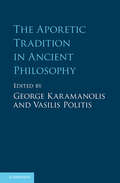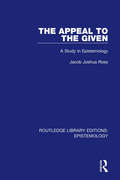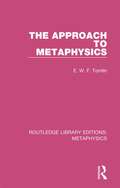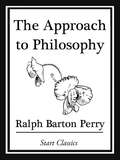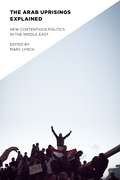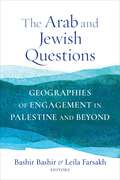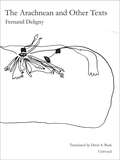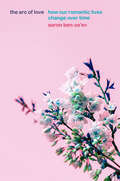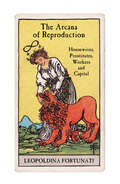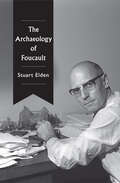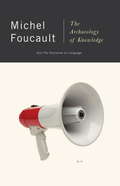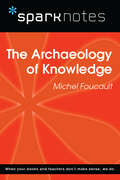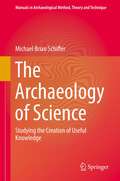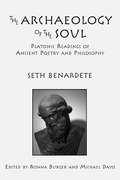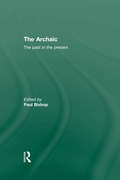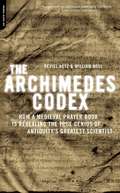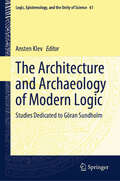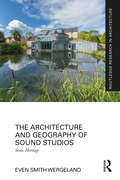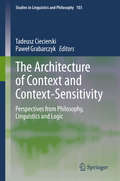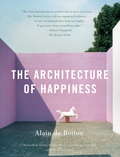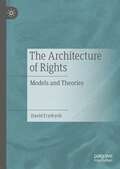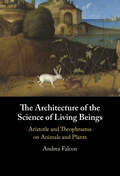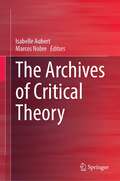- Table View
- List View
The Aporetic Tradition in Ancient Philosophy
by Vasilis Politis George KaramanolisAncient philosophers from an otherwise diverse range of traditions were connected by their shared use of aporia - translated as puzzlement rooted in conflicts of reasons - as a core tool in philosophical enquiry. The essays in this volume provide the first comprehensive study of aporetic methodology among numerous major figures and influential schools, including the Presocratics, Plato, Aristotle, Plutarch, Alexander of Aphrodisias, Academic sceptics, Pyrrhonian sceptics, Plotinus and Damascius. They explore the differences and similarities in these philosophers' approaches to the source, structure, and aim of aporia, their views on its function and value, and ideas about the proper means of generating such a state among thinkers who were often otherwise opposed in their overall philosophical orientation. Discussing issues of method, dialectic, and knowledge, the volume will appeal to those interested in ancient philosophy and in philosophical enquiry more generally.
The Appeal to the Given: A Study in Epistemology (Routledge Library Editions: Epistemology)
by Jacob Joshua RossOriginally published in 1970. This work evaluates the appeal to the sensually given which played an important role in epistemological discussions during the early 20th Century. While many contemporary philosophers regarded this appeal as a mistake, there were still some who defended the notion of the given and even made it the foundation of their views regarding perception. The author here points to several different views concerning the nature of the sensually given and argues that the issue between them is not empirical, as is naturally suggested by what he calls ‘the Naïve View’ of the dispute, but rather metaphysical, involving different theories regarding the relationship between Thought and Reality. This leads on to a discussion of the different views presently held regarding the task of the epistemologist, and to a new suggestion with regard to the relationship between common sense and the rival ontologies suggested by scientists and philosophers. In the course of the argument a variety of different topics are discussed such as the correspondence and coherence theories of truth, the differences between scientific and philosophical theories, and the relevance of scientific treatments of the subject of perception to the treatment of this topic by philosophers.
The Approach to Metaphysics (Routledge Library Editions: Metaphysics)
by E. W. TomlinOriginally published in 1947. This book looks at contemporary conundrums in philosophical tendencies, bringing the reader a first-principles review of the purpose of such enquiries in relation to modern life. It presents the importance of the history of the development of philosophical thought, beginning in Part 1 with perception. Significant definitions and theories are identified and later refinements discussed – in particular conceptualism and its development from the Greeks through Berkeley to modern realism and its limitations and critiques. Part 2 brings problems identified by past thinkersto the fore, from Plato’s forms to Christian theology, in an examination of the apparent dichotomy between metaphysics and scientific methods. Part 3 examines the Rationalist and the Empiricist attacks on Scepticism and Kant’s reconciliation of the differences of both. This provides the context and structure for discussion of the works of Hegel, and ultimate refutation thereof as a confusion between metaphysics and theology. Part 4 identifies the developments in thinking of Positivism, both Modern and Logical, and the New Synthesis of Alexander and Whitehead as the most recent approach.
The Approach to Philosophy
by Ralph Barton PerryPublished in 1905, The Approach to Philosophy was written by Princeton and Harvard educated American philosopher, Ralph Barton Perry
The Arab Uprisings Explained
by Marc LynchWhy did Tunisian protests following the self-immolation of Mohammed Bouazizi lead to a massive wave of uprisings across the entire Arab world? Who participated in those protests, and what did they hope to achieve? Why did some leaders fall in the face of popular mobilization while others found ways to survive? And what have been the lasting results of the contentious politics of 2011 and 2012? The Arab uprisings pose stark challenges to the political science of the Middle East, which for decades had focused upon the resilience of entrenched authoritarianism, the relative weakness of civil society, and what seemed to be the largely contained diffusion of new norms and ideas through new information technologies.In this volume, leading scholars in the field take a sharp look at the causes, dynamics, and effects of the Arab uprisings. Compiled by one of the foremost experts on Middle East politics and society, The Arab Uprisings Explained offers a fresh rethinking of established theories and presents a new framework through which scholars and general readers can better grasp the fast-developing events remaking the region. These essays not only advance the study of political science in the Middle East but also integrate the subject seamlessly into the wider political science literature. Deeply committed to the study of this region and working out the kinks of the discipline, the contributors to this volume help scholars and policymakers across the world approach this unprecedented historical period smartly and effectively.
The Arab Uprisings Explained: New Contentious Politics in the Middle East (Columbia Studies in Middle East Politics)
by Marc LynchWhy did Tunisian protests following the self-immolation of Mohammed Bouazizi lead to a massive wave of uprisings across the entire Arab world? Who participated in those protests, and what did they hope to achieve? Why did some leaders fall in the face of popular mobilization while others found ways to survive? And what have been the lasting results of the contentious politics of 2011 and 2012? <P><P>The Arab uprisings pose stark challenges to the political science of the Middle East, which for decades had focused upon the resilience of entrenched authoritarianism, the relative weakness of civil society, and what seemed to be the largely contained diffusion of new norms and ideas through new information technologies. In this volume, leading scholars in the field take a sharp look at the causes, dynamics, and effects of the Arab uprisings. <P><P>Compiled by one of the foremost experts on Middle East politics and society, The Arab Uprisings Explained offers a fresh rethinking of established theories and presents a new framework through which scholars and general readers can better grasp the fast-developing events remaking the region. These essays not only advance the study of political science in the Middle East but also integrate the subject seamlessly into the wider political science literature. Deeply committed to the study of this region and working out the kinks of the discipline, the contributors to this volume help scholars and policymakers across the world approach this unprecedented historical period smartly and effectively.
The Arab and Jewish Questions: Geographies of Engagement in Palestine and Beyond (Religion, Culture, and Public Life #39)
by Bashir Bashir Leila FarsakhNineteenth-century Europe turned the political status of its Jewish communities into the “Jewish Question,” as both Christianity and rising forms of nationalism viewed Jews as the ultimate other. With the onset of Zionism, this “question” migrated to Palestine and intensified under British colonial rule and in the aftermath of the Holocaust. Zionism’s attempt to solve the “Jewish Question” created what came to be known as the “Arab Question,” which concerned the presence and rights of the Arab population in Palestine. For the most part, however, Jewish settlers denied or dismissed the question they created, to the detriment of both Arabs and Jews in Palestine and elsewhere.This book brings together leading scholars to consider how these two questions are entangled historically and in the present day. It offers critical analyses of Arab engagements with the question of Jewish rights alongside Zionist and non-Zionist Jewish considerations of Palestinian identity and political rights. Together, the essays show that the Arab and Jewish questions, and the Israeli-Palestinian conflict in which they have become subsumed, belong to the same thorny history. Despite their major differences, the historical Jewish and Arab questions are about the political rights of oppressed groups and their inclusion within exclusionary political communities—a question that continues to foment tensions in the Middle East, Europe, and the United States. Shedding new light on the intricate relationships among Orientalism, anti-Semitism, Islamophobia, colonialism, and the impasse in the Israeli-Palestinian conflict, this book reveals the inseparability of Arab and Jewish struggles for self-determination and political equality.Contributors include Gil Anidjar, Brian Klug, Amal Ghazal, Ella Shohat, Hakem Al-Rustom, Hillel Cohen, Yuval Evri, Derek Penslar, Jacqueline Rose, Moshe Behar, Maram Masarwi, and the editors, Bashir Bashir and Leila Farsakh.
The Arabesque from Kant to Comics (Routledge Advances in Art and Visual Studies)
by Cordula GreweThe Arabesque from Kant to Comics tracks the life and afterlife of the arabesque in its surprising transformation from an iconoclastic literary theory of early German Romanticism to aesthetic experimentation in both avant-garde art and popular culture. Its explosive growth in popularity was followed by an inevitable taming as arabesques became staples in book illustration, poetry publications, and even the decoration of printed scores. The subversive potential of the arabesque was preserved in one of its most surprising offspring, the comic strip: born at the moment when the cholera pandemic first swept through Europe, the comic translated the arabesque’s rank growth into unnerving lawlessness and sequences of contagious visual slapstick. Focusing roughly on the period between 1780 and 1880, this book illuminates the intersecting histories of avant-garde theories of writing, visual culture, and even the disciplinary origins of art history. In the process, it explores media history and intermediality, social networks and cultural transfer, as well as the rise of new and nontraditional art forms. This book will be of particular interest to scholars of art history, intellectual history, European art, aesthetics, book illustration, material culture, reproduction, comics, and German history.
The Arachnean and Other Texts (Univocal)
by Fernand DelignyThe Arachnean and Other Texts by Fernand Deligny (1913–1996) is a collection of writings from the second half of the 1970s. In 1968 Deligny established a &“network&” for informally taking care of children with autism that was more than a mere site of living: it was a milieu created out of a reflection on the mode of being autistic. What is a space perceived outside of language? What is the form of a movement without perspective or goal? How do we engage with a world that is not our own, a world turned upside down yet truly common, where acting cohabitates with our actions and the unknown with our forms of knowledge? Such is the mythical web of the &“Arachnean,&” made of lines, holes, traces, enigmas, and questions without answers that demand to see that which cannot be seen. Long before the digital age of social networks, meshworks, and digital webs, Fernand Deligny speaks to us in his own autobiographical and aphoristic manner. For Deligny, his life was always experienced in the form of &“the network as a mode of being.&”
The Arc of Love: How Our Romantic Lives Change Over Time
by Aaron Ben-Ze'evIs love best when it is fresh? For many, the answer is a resounding “yes.” The intense experiences that characterize new love are impossible to replicate, leading to wistful reflection and even a repeated pursuit of such ecstatic beginnings. Aaron Ben-Ze’ev takes these experiences seriously, but he’s also here to remind us of the benefits of profound love—an emotion that can only develop with time. In The Arc of Love, he provides an in-depth, philosophical account of the experiences that arise in early, intense love—sexual passion, novelty, change—as well as the benefits of cultivating long-term, profound love—stability, development, calmness. Ben-Ze’ev analyzes the core of emotions many experience in early love and the challenges they encounter, and he offers pointers for weathering these challenges. Deploying the rigorous analysis of a philosopher, but writing clearly and in an often humorous style with an eye to lived experience, he takes on topics like compromise, commitment, polyamory, choosing a partner, online dating, and when to say “I love you.” Ultimately, Ben-Ze’ev assures us, while love is indeed best when fresh, if we tend to it carefully, it can become more delicious and nourishing even as time marches on.
The Arcana of Reproduction: Housewives, Prostitutes, Workers and Capital
by Leopoldina FortunatiThe definitive feminist analysis of reproductive and &‘caring&’ labor to emerge from Italian feminism of the 1970sEmerging from the great social upheavals that contested the sexual and racial divisions of labor globally in the 1970s, Leopoldina Fortunati&’s classic work expands and transforms how we analyze the sphere of reproduction, redefining the value of the individual&’s life and the labor performed in the home.Released here for the first time in its unabridged form with historical notation and contemporary commentary, The Arcana of Reproduction is a foundational text and essential contribution to today&’s discussions of social reproduction and the history of Italian feminism. Fortunati&’s work provides some of the earliest theorizations of &‘immaterial,&’ &‘affective,&’ and &‘caring&’ labor, and of the role of technology in reproduction, articulated decades before their popular reception in English academic literature.Reading this work some 50 years after its original publication gives us the tools to analyze the contemporary state of capitalist development and of women&’s lives today. The text remains prefigurative and essential in our era of digital labor.
The Archaeology of Foucault
by Stuart EldenOn 20 May 1961 Foucault defended his two doctoral theses; on 2 December 1970 he gave his inaugural lecture at the Collège de France. Between these dates, he published four books, travelled widely, and wrote extensively on literature, the visual arts, linguistics, and philosophy. He taught both psychology and philosophy, beginning his explorations of the question of sexuality. Weaving together analyses of published and unpublished material, this is a comprehensive study of this crucial period. As well as Foucault’s major texts, it discusses his travels to Brazil, Japan, and the USA, his time in Tunisia, and his editorial work for Critique and the complete works of Nietzsche and Bataille. It was in this period that Foucault developed the historical-philosophical approach he called ‘archaeology’ – the elaboration of the archive – which he understood as the rules that make possible specific claims. In its detailed study of Foucault’s archive the book is itself an archaeology of Foucault in another sense, both excavation and reconstruction. This book completes a four-volume series of major intellectual histories of Foucault. Foucault’s Last Decade was published by Polity in 2016; Foucault: The Birth of Power followed in 2017; and The Early Foucault in 2021.
The Archaeology of Knowledge
by Michel FoucaultIn France, a country that awards its intellectuals the status other countries give their rock stars, Michel Foucault was part of a glittering generation of thinkers, one which also included Sartre, de Beauvoir and Deleuze. One of the great intellectual heroes of the twentieth century, Foucault was a man whose passion and reason were at the service of nearly every progressive cause of his time. From law and order, to mental health, to power and knowledge, he spearheaded public awareness of the dynamics that hold us all in thrall to a few powerful ideologies and interests. Arguably his finest work, Archaeology of Knowledge is a challenging but fantastically rewarding introduction to his ideas.
The Archaeology of Knowledge (SparkNotes Philosophy Guide)
by SparkNotesThe Archaeology of Knowledge (SparkNotes Philosophy Guide) Making the reading experience fun! SparkNotes Philosophy Guides are one-stop guides to the great works of philosophy–masterpieces that stand at the foundations of Western thought. Inside each Philosophy Guide you&’ll find insightful overviews of great philosophical works of the Western world.
The Archaeology of Science
by Michael Brian SchifferThis manual pulls together--and illustrates with interesting case studies--the variety of specialized and generalized archaeological research strategies that yield new insights into science. Throughout the book there are templates, consisting of questions, to help readers visualize and design their own projects. The manual seeks to be as general as possible, applicable to any society, and so science is defined as the creation of useful knowledge--the kinds of knowledge that enable people to make predictions. The chapters in Part I discuss the scope of the archaeology of science and furnish a conceptual foundation for the remainder of the book. Next, Part II presents several specialized, but widely practiced, research strategies that contribute to the archaeology of science. In order to thoroughly ground the manual in real-life applications, Part III presents lengthy case studies that feature the use of historical and archaeological evidence in the study of scientific activities.
The Archaeology of the Soul: Platonic Readings of Ancient Poetry and Philosophy
by Seth Benardete; Ronna Burger; Michael DavisAt the same time that he was pursuing a track backward, from Plato to the poets and pre-Socratic philosophers, Benardete was also proceeding on a forward path, from Plato to the Latin writers, who adopt the Platonic way of thinking with full understanding of what it means to be "post-Platonic."
The Archaic: The Past in the Present
by Paul BishopThe Archaic takes as its major reference points C.G. Jung's classic essay, 'Archaic Man' (1930), and Ernesto Grassi's paper on 'Archaic Theories of History' (1990). Moving beyond the confines of a Jungian framework to include other methodological approaches, this book explores the concept of the archaic. Defined as meaning 'old-fashioned', 'primitive', 'antiquated', the archaic is, in fact, much more than something very, very old: it is timeless, inasmuch as it is before time itself. Archē, Urgrund, Ungrund, 'primordial darkness', 'eternal nothing' are names for something essentially nameless, yet whose presence we nevertheless intuit. This book focuses on the reception of myth in the tradition of German Idealism or Romanticism (Creuzer, Schelling, Nietzsche), which not only looked back to earlier thinkers (such as Jacob Boehme) but also laid down roots for developments in twentieth-century thought (Ludwig Klages, Martin Heidegger). The Archaic also includes: studies of the Germanic dimension of the archaic (Charles Bambach, Alan Cardew) a discussion of the mytho-phenomenological approach to the archaic (Robert Josef Kozljanič) a series of articles on Jung's understanding of the archaic (Paul Bishop, Susan Rowland, Robert Segal). This book will be of interest to psychoanalysts, anthropologists and phenomenologists, as well as students of psychology, cultural studies, religious studies, and philosophy, as it seeks to rehabilitate a concept of demonstrable and urgent relevance for our time.
The Archimedes Codex: How a Medieval Prayer Book Is Revealing the True Genius of Antiquity's Greatest Scientist
by Reviel NetzPart archaeological detective story, part science, and part history, The Archimedes Codex tells the astonishing story of a lost manuscript, from its tenth-century creation in ancient Constantinople to the auction block at Christie’s in New York, and how a team of scholars used the latest imaging technology to reveal and decipher the original text. What they found was the earliest surviving manuscript by Archimedes (287 BC#150;212 BC), the greatest mathematician of antiquity#151;a manuscript that established, for the first time, the extent of his mathematical genius, which was two thousand years ahead of modern science.
The Architecture and Archaeology of Modern Logic: Studies Dedicated to Göran Sundholm (Logic, Epistemology, and the Unity of Science #61)
by Ansten KlevThis book honors the original and influential work by Göran Sundholm in the fields of the philosophy and history of logic and mathematics. Borne from two conferences held in Paris and Leiden on the occasion of Göran Sundholm’s retirement in 2019, the contributions collected in this volume represent work from leading logicians and philosophers. Reflecting Sundholm’s contributions to the history and philosophy of logic, this book is divided into two parts: the architecture and archaeology of logic.The essays collected in the ‘architecture’ section cover primarily the systematic approach to basic logical concepts taken by Sundholm, including type theory, epistemic assumptions, and notions of consequence. The ‘archaeology’ section includes contributions focused on Sundholm’s contributions to the history of philosophy and logic. Enclosing these two sections are, on the one end, autobiographical remarks of Sundholm's and, on the other, a paper on cooking and philosophy, reflectinganother of Sundholm's passions in life. This book is of interest to logicians, philosophers, mathematicians, and computer scientists.
The Architecture and Geography of Sound Studios: Sonic Heritage (Routledge Research in Architecture)
by Even Smith WergelandThis is a book about sound studios, focusing on their architectural and geographical aspects. It explores how music is materialized under specific spatial and technological conditions and the myths associated with this process.Through ten in-depth studies, it examines the design, evolution and current function of sound studios amidst economic and technological shifts in the music industry. Traditional studios are in flux between the past and future. The industry, while steeped in romanticism and nostalgia, also embraces forward-driven pragmatism and an extensive reuse culture, encompassing heritage audio, building materials and existing buildings. A surprisingly diverse architectural heritage, the most significant feature is the host building, the framework around the studio capsule. Many traditional studios adapt to digitalization with hybrid solutions, reflecting a shift toward smaller, more versatile spaces. In a time when recordings in theory can happen anywhere, destination studios must excel to attract clients, balancing historical legacies with diversification. Although they may be easy to deconstruct, many of the myths endure, sustaining ideas of landmark recordings, unique locations and distinct remnants of sonic heritage. Courtesy of their capacity to keep the past alive in the present, traditional sound studios are best described as museums that work.This book aims to reach scholars and students with an interest in history, theory and preservation, as well as practicing architects and architectural students who wish to find out more about the relationship between sound and space, acoustic design and retrofitting of historical buildings into specialized functions. It also aims to reach practicing musicians, producers, music students and music scholars.
The Architecture of Context and Context-Sensitivity: Perspectives from Philosophy, Linguistics and Logic (Studies in Linguistics and Philosophy #103)
by Paweł Grabarczyk Tadeusz CiecierskiThis volume addresses foundational issues of context-dependence and indexicality, which are at the center of the current debate within the philosophy of language. Topics include the scope of context-dependency, the nature of content and the character of input data of cognitive processes relevant for the interpretation of utterances. There's also coverage of the role of beliefs and intentions as contextual factors, as well as the validity of arguments in context-sensitive languages.The contributions consider foundational issues regarding context-sensitivity from three different, yet related, perspectives on the phenomenon of context-dependence: representational, structural, and functional. The contributors not only address the representational, structural and/or functional problems separately but also study their mutual connections, thus furthering the debate and bringing competing approaches closer to unification and consensus. This text appeals to students and researchers within the field.This is a very useful collection of essays devoted to the roles of context in the study of language. Its essays provide a useful overview of the current debates on this topic, and they put forth novel contributions that will undoubtedly be of relevance for the development of all areas in philosophy and linguistics interested in the notion of context. Stefano Predelli Department of Philosophy, University of Nottingham, Nottingham, UK
The Architecture of Happiness
by Alain De BottonBestselling author Alain de Botton considers how our private homes and public edifices influence how we feel, and how we could build dwellings in which we would stand a better chance of happiness.In this witty, erudite look at how we shape, and are shaped by, our surroundings, Alain de Botton applies Stendhal's motto that "Beauty is the promise of happiness" to the spaces we inhabit daily. Why should we pay attention to what architecture has to say to us? de Botton asks provocatively.With his trademark lucidity and humour, de Botton traces how human needs and desires have been served by styles of architecture, from stately Classical to minimalist Modern, arguing that the stylistic choices of a society can represent both its cherished ideals and the qualities it desperately lacks. On an individual level, de Botton has deep sympathy for our need to see our selves reflected in our surroundings; he demonstrates with great wisdom how buildings -- just like friends -- can serve as guardians of our identity. Worrying about the shape of our sofa or the colour of our walls might seem self-indulgent, but de Botton considers the hopes and fears we have for our homes at a new level of depth and insight. When shopping for furniture or remodelling the kitchen, we don't just consider functionality but also the major questions of aesthetics and the philosophy of art: What is beauty? Can beautiful surroundings make us good? Can beauty bring happiness? The buildings we find beautiful, de Botton concludes, are those that represent our ideas of a meaningful life. The Architecture of Happiness marks a return to what Alain does best -- taking on a subject whose allure is at once tantalizing and a little forbidding and offering to readers a completely beguiling and original exploration of the subject. As he did with Proust, philosophy, and travel, now he does with architecture.From the Hardcover edition.
The Architecture of Rights: Models and Theories
by David FrydrychWhat is a right? What, if anything, makes rights different from other features of the normative world, such as duties, standards, rules, or principles? Do all rights serve some ultimate purpose? In addition to raising these questions, philosophers and jurists have long been aware that different senses of ‘a right’ abound. To help make sense of this diversity, and to address the above questions, they developed two types of accounts of rights: models and theories. This book explicates rights modelling and theorising and scrutinises their methodological underpinnings. It then challenges this framework by showing why the theories ought to be abandoned. In addition to exploring structural concerns, the book also addresses the various ways that rights can be used. It clarifies important differences between rights exercise, enforcement, remedying, and vindication, and identifies forms of legal rights-claiming and rights-invoking outside of institutional contexts.
The Architecture of the Science of Living Beings: Aristotle and Theophrastus on Animals and Plants
by Andrea FalconScholars have paid ample attention to Aristotle's works on animals. By contrast, they have paid little or no attention to Theophrastus' writings on plants. That is unfortunate because there was a shared research project in the early Peripatos which amounted to a systematic, and theoretically motivated, study of perishable living beings (animals and plants). This is the first sustained attempt to explore how Aristotle and Theophrastus envisioned this study, with attention focused primarily on its deep structure. That entails giving full consideration to a few transitional passages where Aristotle and Theophrastus offer their own description of what they are trying to do. What emerges is a novel, sophisticated, and largely idiosyncratic approach to the topic of life. This title is also available as Open Access on Cambridge Core.
The Archives of Critical Theory
by Marcos Nobre Isabelle AubertOn the occasion of the 100th anniversary of the foundation of the Institute for Social Research in Frankfurt am Main, in 1923, this book aims at shedding light on the archives of some of the key thinkers of Critical Theory of Society, also well known as “Frankfurt School”. To pay homage to this current of thought, this contributed volume aims to make the archives speak for themselves, to show the public the quantity of unpublished material still existing by the authors of the Critical Theory which are now in funds in different parts of the world (in Germany, in Italy, or in the United States), and to show that Critical Theory remains alive 100 years after its inception.The volume starts by presenting the archives of Karl Marx and Friedrich Engels, the thinkers who inspired Critical Theory, and the archives of the Institute for Social Research itself. Then it dedicates separate sections to the archives of Walter Benjamin, Max Horkheimer, Theodor W. Adorno, Friedrich Pollock, Herbert Marcuse, Leo Löwenthal and Jürgen Habermas. The book is composed of chapters written by researchers and editors who worked in the different fonds, as well as chapters written by or interviews with researchers who were or are in charge of some of the archives, or who are especially familiar with the material. The Archives of Critical Theory will be an invaluable tool for researchers in many disciplines working with Critical Theory of Society, such as Sociology, Anthropology, Political Science, Philosophy, History, Education, Law and Cultural Studies, among others. Readers will find information about the content of each archive and the history of its constitution. The various contributions present many ways in which the materials may be explored and explain how such explorations affected or may yet affect the state of the research.
